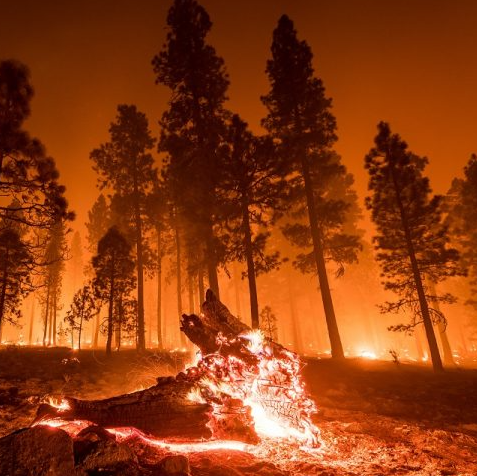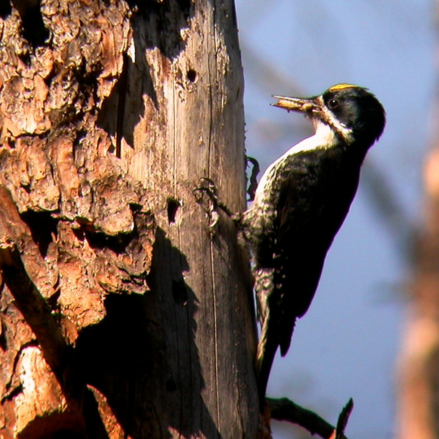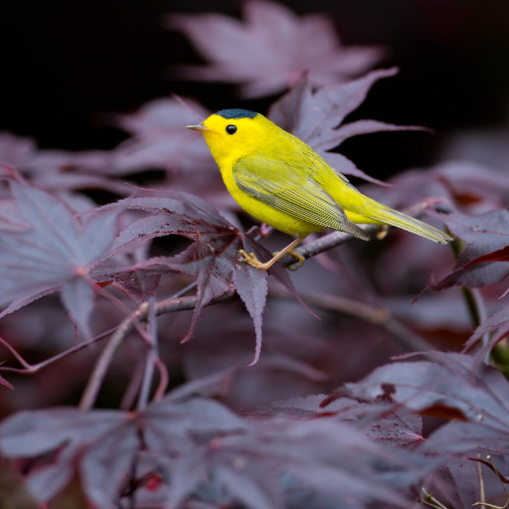
IBP IN THE NEWS

New Study Shows Fire Benefits Many Species in the Long Term
IBP researchers and colleagues have found that low to moderate-severity fires benefit many bird species in the Sierra Nevada, and these benefits may persist for decades. In addition to a handful of bird species already known to be “post-fire specialists”, a broad variety of other more generalist species, like Dark-eyed Juncos and Mountain Chickadees, clearly benefited from wildfire. This research will help land managers make decisions about how to manage forests and fires as they face a changing fire regime. Results of the study, which were published in the journal Fire Ecology, were picked up by numerous news outlets.

How Woodpeckers Can be Used to Aid in Wildfire Recovery
Black-backed woodpeckers "love pyrodiversity," or variation in the way that fires burn, which results in uneven patches burned at high, medium, and low severity, former IBP Biologist Andrew Stillman told ABC News. The species is "highly associated" with the parts of severe wildfire burns that kill all the trees, Stillman said. As the trees die, woodboring beetles colonize them, providing ample food for black-backed woodpeckers and creating cavities in trees for other species of nesting birds, such as blue birds and chickadees, Stillman said.

Animals Are Shape-Shifting in Response to a Warming World
A warming climate is producing changes to size and behavior of many wildlife species. Recently, the highly regarded magazine The Scientist summarized work carried out by several researchers, including Casey Youngflesh who used the MAPS database to look at bird morphology over the past several decades in North America. Examining 105 species’ ranges, he and his colleagues scoured bird banding data compiled by IBP and our many MAPS cooperators and found significant body mass reductions in 80 species over three decades. The analysis included more than 250,000 birds and found that the mean decline in mass across all species was about 0.6 percent, with some species declining by much more.

The MAPS Program in Glacier National Park
The Daily Inter Lake, out of Kalispell Montana, recently featured a story about the MAPS station at Glacier National Park. Each summer since 2020, park biologist Lisa Bate and her colleagues have set up the nets and data-collection station every 10 days to learn more about Glacier’s bird population. “We do this so we can study the causes of bird population changes in North America,” she explained. “We are really looking to get at what are the causes for population decline or increases and whether problems are more serious in winter or breeding grounds. We want to see the trends in different areas and what are the relationships between population changes and changes in weather, climate and habitat loss.”

IBP and the US Fish and Wildlife Service Team Up to Monitor Birds in New England
The MAPS program and our cooperators at the Silvio O. Conte National Wildlife Refuge in Hadley, Massachusetts were recently featured in a story was recently featured in a story in the Hampshire Gazette. Biologists Caleb Spiegel, Randy Detmers, and others have been operating the station for 7 years. He noted that having nationwide data archived in a single place (i.e., with IBP), allows conservation professionals to "look at wider trends as well and see if a species is doing well or if there are not as many. With a really large set of data you’re not just looking at the life history, but the status of a species."

Bridging Boundaries to Protect Migratory Birds
IBP has long understood the need to study and protect birds through their full annual cycle. That's why much of our conservation effort is aimed at establishing partners south of the U.S. border, where more than half of all U.S. breeding birds spend more than half the year. Recently some of IBP's efforts, along with those of our collaborators in the National Park Service (NPS) were featured in Park Science, the flagship science magazine of the NPS.

IBP's Partnership with the Bird Genoscape Project Highlighted by Audubon
IBP's long-running and productive partnership with the Bird Genoscape Project, which strives to illuminate the migratory connections between specific populations of birds, was recently featured in an article by the National Audubon Society. The article specifically noted the contributions made by the many MAPS and MoSI cooperators who have collected feathers for this effort.

MAPS Program featured in Audubon Magazine
IBP's MAPS program was prominently featured in a recent article from Audubon Magazine about bird banding, and opportinities for the public to view birds up close.

IBP Scientist Highlighted in National Geographic
Recently, IBP Scientist Chris Ray was highlighted in a National Geographic story about the Pika Project, a partnership between the Denver Zoo and Rocky Mountain Wild, a Denver-based nonprofit. The project’s mission is to document and collect key information about pikas and their habitat, and to use that information to better understand how climate change could be threatening the survival of certain pika populations.
.png)
Canadian Banders Promote Conservation Through Banding
MAPS Program Coordinator Danielle Kaschube was recently featured in an article about an Alberta area couple, Martine Dumont (pictured) and Normand Legault, who are striving to build a bird banding station at a nature reserve near Edmonton. In an article in Saint Albert Gazette, Legault said that he and Dumont were longtime birdwatchers who got into bird-banding a few years ago after contacting Danielle and learning about the MAPS program. “We humans need nature to survive,” Legault said, and birds were important indicators of nature’s health.

IBP's Work with Black-backed Woodpeckers Draws Attention
The black-backed woodpecker relies on burned forests for its survival, nesting in cavities of dead and dying trees, and eating beetle grubs that proliferate in fire-killed trees. But not all fires are equal. Recently the North Bay Bohemian featured an article about IBP’s work documenting how the species responds to different types of fires, and how a diversity of fire types and intensities – pyrodiversity – affects Black-backed Woodpecker ecology.

Dying Birds and Forest Fires: Scientists Work to Unravel a Mystery
IBP Executive Director Rodney Siegel was quoted in a recent story in The Guardian newspaper that explored the causes of recent massive die-offs of birds. “These enormous smoke plumes are harder to escape than those from smaller fires that have been more typical for the last century,” Siegel said. “This is a really unusual phenomenon without a lot of precedent – and it is unknown how that might affect birds.”
.jpg)
Whitebark Pine Declines May Unravel the Tree's Mutualism with Clark's Nutcracker
The relationship between the whitebark pine, an iconic tree of western mountaintops, and the Clark's Nutcracker is often cited as an example of mutualism, a relationship between species where both benefit. The pine provides nutritious seeds which the nutcracker eats or buries for later use, some of the latter of which germinate to become the next generation of pines. But while the pine depends heavily on nutcrackers for seed dispersal and germination, the nutcracker merely prefers the whitebark pine's seeds. If whitebark pine seeds aren't available or abundant, the highly mobile nutcracker will find another food source. But a study by IBP and others suggests that the pine-nutcracker mutualism may be threatened by local declines in the tree's population.

Bird Banding at Kalamazoo Nature Center Helps Track Migration Patterns
A long-time MAPS partner, The Kalamazoo Nature Center, was recently featured in a news story about migratory birds. The article also notes IBP's work in coordinating the MAPS program.

IBP's Work with Woodpeckers Highlighted by National Geographic
IBP is fast becoming a leading expert on the impacts of fire to birds in forest ecosystems in the West, especially through our work with the Black-backed Woodpecker. Recently, in a story about woodpeckers and fire, National Geographic described some of our work, along with that of other researchers.

IBP Study Reveals Megafire Does Not Deter Yosemite's Spotted Owls
In 2013 the Rim Fire–the largest fire on record in the Sierra Nevada–burned one third of the potential California Spotted Owl habitat in Yosemite National Park. The park provides prime habitat for this subspecies, which is listed as a Species of Special Concern by the California Department of Fish and Wildlife, and concern grew regarding the fire's effect on Yosemite's owl populations. But recent research provides some good news regarding the park's owls, and it may be due to Yosemite's unique history and fire management strategy. Several news outlets picked up the story, including the Montanta Standard, which produced a kid-friendly synopsis of the story and a cartoon to accompany it.

U.S. Army Helps Conserve Biodiversity Through the MAPS Program
The U.S. Army has been a partner in the MAPS Program for decades. A recent story in some of the Department of Defense's new media highlighted the efforts of biologists at Fort Hunter Liggett near Monterey, California.

Audubon Great Lakes Starts MAPS Station in the Heart of Chicago
A new bird banding station at Big Marsh Park near the center of Chicago will give researchers a better sense of the local avifauna's population status and health, while also contributing to broader studies aimed at understanding the causes behind the dramatic decline in North America’s birds and determining which conservation measures have the most promise. The opening of the station was recently reported by WTTW, Chicago's Public Television station, on their website.

Researchers Look for Answers as to Why Western Bumble Bees Are Declining
The decline of the Western bumblebee is likely not limited to one culprit but, instead, due to several factors that interact such as pesticides, pathogens, climate change and habitat loss. IBP was recently involved in a study that tried to tease apart the various factors affecting this species.

New Study Helps Bumble Bees by Identifying Their Favorite Flowers
Many species of North American bumble bees have seen significant declines in recent decades. Bumble bees are essential pollinators for both native and agricultural plants, but not all flowers are used equally by bumble bees and, just as importantly, not all flowers are equally available to them. New research by IBP scientists and our colleagues and published in the journal Environmental Entomology examines which flowers bumble bees select in the Sierra Nevada region of California, information that can be useful to land managers who are restoring or managing meadows and other riparian habitat for native bees.
Photo Credits, from top: Bird in the Hand courtesy of the Daily Hampshire Gazette; Environmental Education courtesy of Park Science; Wilson's Warbler courtesy of Flickr Creative Commons; Pika by Kristi Odom; Banding by Martine Dumont; Wildfire by Curtis Gregory Perry; Clark's Nutcracker by Gail Hampshire; Bird band by Will Haenni; Red-cockaded Woodpecker chick by Taylor Kennedy, Cartoon by Potter, Bird Bander by Cynthia McIntyre, Yellow Warbler by Silver Leapers via Flickr CC, Western Bumble Bee by IBP, Northern Goshawk by Martha de Jong-Lantink; Kentucky Warbler by Eric Soehren; Fire by USDA Forest Service; Tree Swallow by Bradley Boner; Student by Dan Shrubshell; Peregrine Falcon by The Institute for Wildlife Studies; Northern Cardinal by Steven Albert; Eastern Prairie Orchid by Joshua Mayer; American Goldfinch courtesy of The Prairie Naturalist; Indigo Bunting by Matt Stratmoen; Sierra meadow wildflowers by Dawn Endico; Micronesian Kingfisher by DW Ross; Bryan's Shearwater by Reginald David; West Nile Virus courtesy Washington University of St. Louis; American Kestrel by Rob Crowe; Migratory Connectivity Map courtesy UCLA; Black-and-white Warbler by Peter Wilton; Burrowing Owl by Hans Splinter; Mirrow Lake by Rickz; MAPS Bandng by IBP








